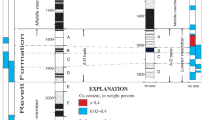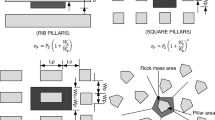Abstract
In this study, a parametric study was conducted using FLAC3D numerical models to examine the impact of oblique loading, generated from seam dip, on the strength and the failure propagation pattern of a stone pillar using two simplified geometry types. In type 1, the sidewalls of the pillars were assumed to be perpendicular to the roof and the floor, while in type 2, the sidewalls of pillars were assumed to be vertical. The complex pillar geometry in dipping mines was frequently modeled using these two geometries. To capture a complete picture of the effect of seam dip on pillar stability, the modeled width-to-height (W/H) ratio of the pillars, in situ stress field, and pillars roof/floor interfaces were systematically varied to account for the potential distribution of values for these parameters across the underground stone mines in USA. Results from the numerical modeling indicate that dipping pillars have reduced strength compared with horizontal pillars. Also, an asymmetric failure propagation pattern could be obtained depending on an interaction between the W/H ratio, seam dip, in situ stresses, and pillar geometry.













Similar content being viewed by others
References
Brady BHG, Brown ET (2005) Rock Mechanics for underground mining, 3rd edition. Springer, Dordecht, The Netherlands
Cai M (2007) Determination of residual strength parameters of jointed rock masses using the GSI system. Int J Rock Mech Min Sci 44:247–265
Esterhuizen GS, Ellenberger JL (2007) Effects of weak bands on pillar stability in stone mines: Field observations and numerical model assessment. Proceedings of the 26th International Conference on Ground Control in Mining, Morgantown, West Virginia. pp. 320-326
Esterhuizen GS, Dolinar DR, Ellenberger JL, Prosser LJ (2011) Pillar and roof span design guidelines for underground stone mines. Pittsburgh, PA: U. S. Department of Health and Human Services, Public Health Service, Centers for Disease Control and Prevention, National Institute for Occupational Safety and Health, DHHS (NIOSH) Publication No. 2011-171, IC 9526, 2011 May; :1-64. Retrieved from http://www.cdc.gov/niosh/mining/works/coversheet1355.html
Gale WJ (1998) Coal pillar design issues in longwall mining. In Aziz, N(ed), coal operators’ conference, University of Wollongong & the Australasian Institute of Mining and Metallurgy, pp. 133-146
Hedley DGF (1992) Rockburst handbook for Ontario hardrock mines. CANMET Special Report SP92- 1E. Canada Communication Group, Ottawa. pp:23 1-242
Hedley DGF, Grant F (1972) Stope and pillar design for the Elliot lake uranium mines. CIM Bull 65:37–44
Hoek E, Brown ET (1980) Underground excavations in rock. Published by the Institute of Mining and Metallurgy, London, p 526
Hoek E, Brown ET (2018) The Hoek-Brown failure criterion and GSI – 2018 edition. J Rock Mech Geotech Eng. https://doi.org/10.1016/j.jrmge.2018.08.00
Hoek E, Diederichs MS (2006) Empirical estimation of rock mass modulus. Int J Rock Mech Min Sci 43(2):203–2015
Hoek E, Kaiser PK, Bawden WF (2006) Support of underground excavations in hard rock. Published by Taylor & Francis. pp. 215
Iannacchione T (1999) Analysis of pillar design practices and techniques for U.S. limestone mines. Trans Inst Min Metall (sect A: Min Industry) 108:A152–A160
Itasca Consulting Group (2018) Fast Lagrangian analysis of continua in 3dimensions. Minneapolis, Itasca Consulting Group
Jackson R, Gorski B, Gyenge M (1995) Geotechnical properties of rock: a data base of physical properties of Canadian rock including both intact and residual strengths. Published by Canada Communication Group. pp. 15-91
Jessu KV, Spearing AJS (2018) Effect of dip on pillar strength. J Southern African Inst Mining Metall 118:765–776
Krauland N, Soder P (1987) Determining pillar strength from pillar failure observation. E&MJ. pp. 34-40
Kvapil RL, Beaza JR, Flores G (1989) Block caving at EI Teniente Mine, Chile. Inst Min Metall 98(6):A43–A56
Lorig LJ, Cabrera A (2013) Pillar strength estimates for foliated and inclined pillars in Schistose material, in Continuum and Distinct Element Numerical Modeling in Geomechanics. (CD Proceedings, 3rd International FLAC/DEM Symposium, Hangzhou, China, October 2013). Paper: 01-01, H. Zhu et al., Eds. Minneapolis: Itasca International, Inc
Lunder PJ, Pakalnis RC (1997) Determination of the strength of hard-rock mine pillars. Bull Can Inst Min Metall 90(1013):51–55
Martin CD, Maybee WG (2000) The strength of hard rock pillars. Int J Rock Mech Min Sci 37:1239–1246
Murphy M, Esterhuizen GS, Slaker B (2020) Addressing stone mine pillar design with the NIOSH S-Pillar software. SME Annual Meeting, Feb. 24 - 27, Phoenix, AZ
Newman C, Newman D, Dupuy R (2019) The development of a multiple level underground limestone mine from geology through mine planning. Proceedings of the 38th International Conference on Ground Control in Mining. Pp. 116-121
Obert L, Duvall W (1967) Rock mechanics and the design of structure in rock. John Wiley & Sons, Inc., New York, p 650
Pariseau WG (1982) Shear stability of mine pillars in dipping seams. 23rd U.S. Symposium on Rock Mechanics (USRMS). Berkeley, California
Peng SS, Johnson AM (1972) Crack growth and faulting in cylindrical specimens of Chelmsford Granite. Int J Rock Mech Min Sci 9(1):37–86
Potvin Y, Hudyrna M, Miller HDS (1989) Rib pillar design in open stope minining. Bull Can Inst Min Metall 82(927):31–36
Rashed G, Peng SS (2015) Change of the mode of failure by interface friction and width-to-height ratio of coal specimens. Int J Rock Mech Geotechn Eng 7(3):256–265
Salamon MDG, Munro AH (1967) A study of the strength of coal pillars. South Afr Inst Min Metall 68:55–67
Sjoberg J (1992) Failure modes and pillar behaviour in the Zinkgruvan mine. Rock Mechanics, Tillerson & Wawersik (eds). Balkema, Rotterdam
Suorineni FT, Mgumbwa JJ, Kaiser PK, Thibodeau D (2011) Mining of orebodies under shear loading. Part 1 – case histories. Transact Inst Mining Metall A: Mining Technol 120(3):138–147
Suorineni FT, Mgumbwa JJ, Kaiser PK, Thibodeau D (2014) Mining of orebodies under shear loading. Part 2 – failure modes and mechanisms. Article Mining Technol IMM Transact A. https://doi.org/10.1179/1743286314Y.0000000072
Von Kimmelmann MR, Hyde B, Madgwick RJ (1984) The use of computer applications at BCL limited in planning pillar extraction and the design of mining layouts. Design and performance of underground excavations. ISRM/BGS, Cambridge, pp 53–63
Whyatt J, Varley F (2008) Catastrophic failures of underground evaporite mines, Proc. 27th Int. Conf. on Ground control in mining, Morgantown, WV. pp. 113–122
Zipf RK (2001) Pillar design to prevent collapse of room-and-pillar mines. In: Hustrulid WA, Bullock RC (eds) Underground mining methods: engineering fundamentals and international case studies. Denver, Soc. Min. Metall. Expl., pp 493–511
Author information
Authors and Affiliations
Corresponding author
Ethics declarations
Disclaimer
The findings and conclusions in this paper are those of the authors and do not necessarily represent the official position of the National Institute for Occupational Safety and Health, Centers for Disease Control and Prevention.
Conflict of Interest
The author states that there is no conflict of interest.
Additional information
Publisher’s Note
Springer Nature remains neutral with regard to jurisdictional claims in published maps and institutional affiliations.
Rights and permissions
About this article
Cite this article
Rashed, G., Slaker, B., Sears, M.M. et al. A Parametric Study for the Effect of Dip on Stone Mine Pillar Stability Using a Simplified Model Geometry. Mining, Metallurgy & Exploration 38, 967–977 (2021). https://doi.org/10.1007/s42461-021-00394-y
Received:
Accepted:
Published:
Issue Date:
DOI: https://doi.org/10.1007/s42461-021-00394-y




